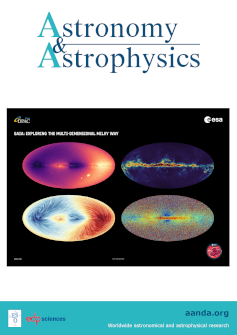非凌日系外行星作为理解近距离系统中恒星-行星相互作用的手段
IF 5.8
2区 物理与天体物理
Q1 ASTRONOMY & ASTROPHYSICS
引用次数: 0
摘要
先前的研究表明,在快速旋转的行星周围缺乏近距离的系外行星,这可以用行星与其主恒星之间强烈的潮汐和磁场相互作用的共同作用来解释。因此,探测更多经历这种相互作用的系外行星,以及轨道在短时间尺度上的演变,对于提高我们对潜在物理机制的理解至关重要。为此,我们在开普勒数据中对近距离非凌日伴星进行了新的搜索,重点关注轨道周期低于2.3天的伴星。我们重点研究了测量了表面旋转周期的主序太阳型恒星和亚巨星。对于每一颗恒星,我们在光曲线的功率谱密度中寻找一个过剩,这可能对应于一个近距离非凌日伴星的特征。我们将候选目录与现有目录进行比较,以消除样品中的潜在污染物,并目视检查相折叠光曲线及其小波分解。我们确定了88颗恒星,它们的特征与一颗近距离的非凌星伴星的存在一致。我们表明,我们样本中的物体大多位于死区内,强调了对这些系统进行后续调查的重要性,以便收集恒星-行星相互作用的观测证据。本文章由计算机程序翻译,如有差异,请以英文原文为准。
Non-transiting exoplanets as a means of understanding star–planet interactions in close-in systems
Previous studies showed evidence of a dearth of close-in exoplanets around fast rotators, which can be explained by the combined action of intense tidal and magnetic interactions between planets and their host star. Detecting more exoplanets experiencing such interactions, with orbits evolving on short timescales, is therefore crucial to improve our understanding of the underlying physical mechanisms. For this purpose, we performed a new search for close-in non-transiting substellar companions in the Kepler data, focusing on orbital periods below 2.3 days. We focused on main-sequence solar-type stars and subgiant stars for which a surface rotation period was measured. For each star, we looked for an excess in the power spectral density of the light curve, which could correspond to the signature of a close-in non-transiting companion. We compared our candidates with existing catalogues to eliminate potential contaminants in our sample, and we visually inspected the phase-folded light curve and its wavelet decomposition. We identify 88 stars exhibiting a signature consistent with the presence of a close non-transiting substellar companion. We show that the objects in our sample are located mostly within the dearth zone, emphasising the importance of performing follow-up of such systems in order to gather observational evidence of star-planet interactions.
求助全文
通过发布文献求助,成功后即可免费获取论文全文。
去求助
来源期刊

Astronomy & Astrophysics
地学天文-天文与天体物理
CiteScore
10.20
自引率
27.70%
发文量
2105
审稿时长
1-2 weeks
期刊介绍:
Astronomy & Astrophysics is an international Journal that publishes papers on all aspects of astronomy and astrophysics (theoretical, observational, and instrumental) independently of the techniques used to obtain the results.
 求助内容:
求助内容: 应助结果提醒方式:
应助结果提醒方式:


